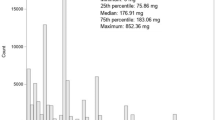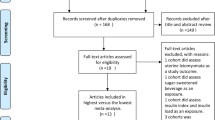Abstract
Purpose
Whether coffee modulates response to endocrine therapy in breast cancer patients is currently unknown. The CYP1A2 and CYP2C8 enzymes contribute to tamoxifen and caffeine metabolism. The purpose was to investigate the impact of coffee consumption on tumor characteristics and risk for early events in relation to breast cancer treatment and CYP1A2 and CYP2C8 genotypes.
Methods
Questionnaires regarding lifestyle were completed preoperatively by 634 patients in southern Sweden. CYP1A2*1F and CYP2C8*3 were genotyped. Clinical data and tumor characteristics were obtained from patients’ charts, population registries, and pathology reports. Coffee consumption was categorized as low (0–1 cups/day), moderate (2–4 cups/day), or high (5+ cups/day).
Results
The proportion of estrogen receptor negative (ER–) tumors increased with increasing coffee consumption (p trend = 0.042). Moderate to high consumption was associated with lower frequency of discordant receptor status (ER + PgR–) OR 0.38 (0.23–0.63) compared to low consumption. Median follow-up time was 4.92 (IQR 3.01–6.42) years. Tamoxifen-treated patients with ER+ tumors (n = 310) who consumed two or more cups/day had significantly decreased risk for early events compared to patients with low consumption, adjusted HR 0.40 (0.19–0.83). Low consumption combined with at least one CYP1A2*1F C-allele (n = 35) or CYP2C8*3 (n = 13) was associated with a high risk for early events in tamoxifen-treated patients compared to other tamoxifen-treated patients, adjusted HRs 3.49 (1.54–7.91) and 6.15 (2.46–15.36), respectively.
Conclusion
Moderate to high coffee consumption was associated with significantly decreased risk for early events in tamoxifen-treated patients and modified hormone receptor status. If confirmed, new recommendations regarding coffee consumption during tamoxifen treatment may be warranted.




Similar content being viewed by others
References
The National Board of Health and Welfare (2011) Cancer incidence in Sweden 2010. http://www.socialstyrelsen.se/Lists/Artikelkatalog/Attachments/18530/2011-12-15.pdf
Fernö M, Borg Å, Johansson U, Norgren A, Olsson H, Ryden S, Sellberg G (1990) Estrogen and progesterone receptor analyses in more than 4,000 human breast cancer samples. A study with special reference to age at diagnosis and stability of analyses. Southern Swedish Breast Cancer Study Group. Acta Oncol 29(2):129–135
Larsson SC, Bergkvist L, Wolk A (2009) Coffee and black tea consumption and risk of breast cancer by estrogen and progesterone receptor status in a Swedish cohort. Cancer Causes Control 20(10):2039–2044. doi:10.1007/s10552-009-9396-x
Conzen SD (2008) Minireview: nuclear receptors and breast cancer. Mol Endocrinol 22(10):2215–2228. doi:10.1210/me.2007-0421
Osborne CK, Schiff R (2011) Mechanisms of endocrine resistance in breast cancer. Annu Rev Med 62:233–247. doi:10.1146/annurev-med-070909-182917
Li J, Seibold P, Chang-Claude J, Flesch-Janys D, Liu J, Czene K, Humphreys K, Hall P (2011) Coffee consumption modifies risk of estrogen-receptor negative breast cancer. Breast Cancer Res 13(3):R49. doi:10.1186/bcr2879
The European Coffee Federation (2010) The European coffee report, vol 2011. The European Coffee Federation. http://www.scribd.com/doc/45025346/European-Coffee-Report-2009
Allred KF, Yackley KM, Vanamala J, Allred CD (2009) Trigonelline is a novel phytoestrogen in coffee beans. J Nutr 139(10):1833–1838. doi:10.3945/jn.109.108001
Michels KB, Holmberg L, Bergkvist L, Wolk A (2002) Coffee, tea, and caffeine consumption and breast cancer incidence in a cohort of Swedish women. Ann Epidemiol 12(1):21–26
Freedman ND, Park Y, Abnet CC, Hollenbeck AR, Sinha R (2012) Association of coffee drinking with total and cause-specific mortality. N Engl J Med 366(20):1891–1904. doi:10.1056/NEJMoa1112010
Svenska bröstcancergruppen (2011) Nationella riktlinjer 2011, vårdprogram.. http://www.swebcg.se/Files/Docs/Nationella_riktlinjer110131.pdf. Accessed 20110512 2011
Jordan VC, Koerner S (1975) Tamoxifen (ICI 46,474) and the human carcinoma 8S oestrogen receptor. Eur J Cancer 11(3):205–206
Jin Y, Desta Z, Stearns V, Ward B, Ho H, Lee KH, Skaar T, Storniolo AM, Li L, Araba A, Blanchard R, Nguyen A, Ullmer L, Hayden J, Lemler S, Weinshilboum RM, Rae JM, Hayes DF, Flockhart DA (2005) CYP2D6 genotype, antidepressant use, and tamoxifen metabolism during adjuvant breast cancer treatment. J Natl Cancer Inst 97(1):30–39. doi:10.1093/jnci/dji005
Dunn BK, Greene MH, Kelley JM, Costantino JP, Clifford RJ, Hu Y, Tang G, Kazerouni N, Rosenberg PS, Meerzaman DM, Buetow KH (2010) Novel pathway analysis of genomic polymorphism-cancer risk interaction in the breast cancer prevention trial. Int J Mol Epidemiol Genet 1(4):332–349
Chen J, Halls SC, Alfaro JF, Zhou Z, Hu M (2004) Potential beneficial metabolic interactions between tamoxifen and isoflavones via cytochrome P450-mediated pathways in female rat liver microsomes. Pharm Res 21(11):2095–2104
Andersson H, Helmestam M, Zebrowska A, Olovsson M, Brittebo E (2010) Tamoxifen-induced adduct formation and cell stress in human endometrial glands. Drug Metab Dispos 38(1):200–207. doi:10.1124/dmd.109.029488
Kot M, Daniel WA (2008) The relative contribution of human cytochrome P450 isoforms to the four caffeine oxidation pathways: an in vitro comparative study with cDNA-expressed P450 s including CYP2C isoforms. Biochem Pharmacol 76(4):543–551. doi:10.1016/j.bcp.2008.05.025
Bågeman E, Ingvar C, Rose C, Jernström H (2008) Coffee consumption and CYP1A2*1F genotype modify age at breast cancer diagnosis and estrogen receptor status. Cancer Epidemiol Biomarkers Prev 17(4):895–901. doi:10.1158/1055-9965.EPI-07-0555
Sachse C, Brockmoller J, Bauer S, Roots I (1999) Functional significance of a C–>A polymorphism in intron 1 of the cytochrome P450 CYP1A2 gene tested with caffeine. Br J Clin Pharmacol 47(4):445–449
Djordjevic N, Ghotbi R, Jankovic S, Aklillu E (2010) Induction of CYP1A2 by heavy coffee consumption is associated with the CYP1A2 -163C > A polymorphism. Eur J Clin Pharmacol 66(7):697–703. doi:10.1007/s00228-010-0823-4
Jernström H, Bågeman E, Rose C, Jönsson PE, Ingvar C (2009) CYP2C8 and CYP2C9 polymorphisms in relation to tumour characteristics and early breast cancer related events among 652 breast cancer patients. Br J Cancer 101(11):1817–1823. doi:10.1038/sj.bjc.6605428
Ringberg A, Bågeman E, Rose C, Ingvar C, Jernström H (2006) Of cup and bra size: reply to a prospective study of breast size and premenopausal breast cancer incidence. Int J Cancer 119(9):2242–2243. Author reply 2244. doi:10.1002/ijc.22104
Osborne CK, Yochmowitz MG, Knight WA 3rd, McGuire WL (1980) The value of estrogen and progesterone receptors in the treatment of breast cancer. Cancer 46(12 Suppl):2884–2888
Cui X, Schiff R, Arpino G, Osborne CK, Lee AV (2005) Biology of progesterone receptor loss in breast cancer and its implications for endocrine therapy. J Clin Oncol 23(30):7721–7735. doi:10.1200/JCO.2005.09.004
Bardou VJ, Arpino G, Elledge RM, Osborne CK, Clark GM (2003) Progesterone receptor status significantly improves outcome prediction over estrogen receptor status alone for adjuvant endocrine therapy in two large breast cancer databases. J Clin Oncol 21(10):1973–1979. doi:10.1200/JCO.2003.09.099
Hashimoto T, He Z, Ma WY, Schmid PC, Bode AM, Yang CS, Dong Z (2004) Caffeine inhibits cell proliferation by G0/G1 phase arrest in JB6 cells. Cancer Res 64(9):3344–3349
Cui X, Zhang P, Deng W, Oesterreich S, Lu Y, Mills GB, Lee AV (2003) Insulin-like growth factor-I inhibits progesterone receptor expression in breast cancer cells via the phosphatidylinositol 3-kinase/Akt/mammalian target of rapamycin pathway: progesterone receptor as a potential indicator of growth factor activity in breast cancer. Mol Endocrinol 17(4):575–588. doi:10.1210/me.2002-0318
Divekar SD, Storchan GB, Sperle K, Veselik DJ, Johnson E, Dakshanamurthy S, Lajiminmuhip YN, Nakles RE, Huang L, Martin MB (2011) The role of calcium in the activation of estrogen receptor-alpha. Cancer Res 71(5):1658–1668. doi:10.1158/0008-5472.CAN-10-1899
Caldarella A, Crocetti E, Bianchi S, Vezzosi V, Urso C, Biancalani M, Zappa M (2011) Female breast cancer status according to ER, PR and HER2 expression: a population based analysis. Pathol Oncol Res. doi:10.1007/s12253-011-9381-z
Jernström H, Klug TL, Sepkovic DW, Bradlow HL, Narod SA (2003) Predictors of the plasma ratio of 2-hydroxyestrone to 16alpha-hydroxyestrone among pre-menopausal, nulliparous women from four ethnic groups. Carcinogenesis 24(5):991–1005
Bradlow HL, Jernström H, Sepkovic DW, Klug TL, Narod SA (2006) Comparison of plasma and urinary levels of 2-hydroxyestrogen and 16 alpha-hydroxyestrogen metabolites. Mol Genet Metab 87(2):135–146. doi:10.1016/j.ymgme.2005.08.001
Klug TL, Bågeman E, Ingvar C, Rose C, Jernström H (2006) Moderate coffee and alcohol consumption improves the estrogen metabolite profile in adjuvant treated breast cancer patients: a pilot study comparing pre- and post-operative levels. Mol Genet Metab 89(4):381–389. doi:10.1016/j.ymgme.2006.08.005
Schneider J, Huh MM, Bradlow HL, Fishman J (1984) Antiestrogen action of 2-hydroxyestrone on MCF-7 human breast cancer cells. J Biol Chem 259(8):4840–4845
Telang NT, Suto A, Wong GY, Osborne MP, Bradlow HL (1992) Induction by estrogen metabolite 16 alpha-hydroxyestrone of genotoxic damage and aberrant proliferation in mouse mammary epithelial cells. J Natl Cancer Inst 84(8):634–638
Thibodeau PA, Bissonnette N, Bedard SK, Hunting D, Paquette B (1998) Induction by estrogens of methotrexate resistance in MCF-7 breast cancer cells. Carcinogenesis 19(9):1545–1552
Lee AJ, Cai MX, Thomas PE, Conney AH, Zhu BT (2003) Characterization of the oxidative metabolites of 17beta-estradiol and estrone formed by 15 selectively expressed human cytochrome p450 isoforms. Endocrinology 144(8):3382–3398
Berthou F, Flinois JP, Ratanasavanh D, Beaune P, Riche C, Guillouzo A (1991) Evidence for the involvement of several cytochromes P-450 in the first steps of caffeine metabolism by human liver microsomes. Drug Metab Dispos 19(3):561–567
Bahadur N, Leathart JB, Mutch E, Steimel-Crespi D, Dunn SA, Gilissen R, Houdt JV, Hendrickx J, Mannens G, Bohets H, Williams FM, Armstrong M, Crespi CL, Daly AK (2002) CYP2C8 polymorphisms in Caucasians and their relationship with paclitaxel 6alpha-hydroxylase activity in human liver microsomes. Biochem Pharmacol 64(11):1579–1589
Larsson SC, Giovannucci E, Wolk A (2006) Coffee consumption and stomach cancer risk in a cohort of Swedish women. Int J Cancer 119(9):2186–2189. doi:10.1002/ijc.22105
Jernström H, Frenander J, Fernö M, Olsson H (1999) Hormone replacement therapy before breast cancer diagnosis significantly reduces the overall death rate compared with never-use among 984 breast cancer patients. Br J Cancer 80(9):1453–1458. doi:10.1038/sj.bjc.6690543
Schuetz F, Diel IJ, Pueschel M, von Holst T, Solomayer EF, Lange S, Sinn P, Bastert G, Sohn C (2007) Reduced incidence of distant metastases and lower mortality in 1072 patients with breast cancer with a history of hormone replacement therapy. Am J Obstet Gynecol 196(4):342 e341–349. doi:10.1016/j.ajog.2006.10.901
Nanda K, Bastian LA, Schulz K (2002) Hormone replacement therapy and the risk of death from breast cancer: a systematic review. Am J Obstet Gynecol 186(2):325–334
Stahlberg C, Lynge E, Andersen ZJ, Keiding N, Ottesen B, Rank F, Hundrup YA, Obel EB, Pedersen AT (2005) Breast cancer incidence, case-fatality and breast cancer mortality in Danish women using hormone replacement therapy–a prospective observational study. Int J Epidemiol 34(4):931–935. doi:10.1093/ije/dyi103
Chlebowski RT, Anderson GL, Gass M, Lane DS, Aragaki AK, Kuller LH, Manson JE, Stefanick ML, Ockene J, Sarto GE, Johnson KC, Wactawski-Wende J, Ravdin PM, Schenken R, Hendrix SL, Rajkovic A, Rohan TE, Yasmeen S, Prentice RL (2010) Estrogen plus progestin and breast cancer incidence and mortality in postmenopausal women. JAMA 304(15):1684–1692. doi:10.1001/jama.2010.1500
Markkula A, Hietala M, Henningson M, Ingvar C, Rose C, Jernström H (2012) Clinical profiles predict early nonadherence to adjuvant endocrine treatment in a prospective breast cancer cohort. Cancer Prev Res (Phila) 5(5):735–745. doi:10.1158/1940-6207.CAPR-11-0442
Acknowledgments
This work was supported by grants from The Swedish Cancer Society CAN 2011/497, the Swedish Research Council K2012-54X-22027-01-3 (PI H Jernström), the Medical Faculty at Lund University; the Mrs. Berta Kamprad’s Foundation, the Gunnar Nilsson Foundation, the Swedish Breast Cancer Group (BRO), the South Swedish Health Care Region (Region Skåne ALF), Konung Gustaf V:s Jubileumsfond, and Lund Hospital Fund. We thank our research nurses Maj-Britt Hedenblad, Karin Henriksson, Anette Möller, Monika Meszaros, Anette Ahlin Gullers, and Linda Ågren. We thank Sol-Britt Olsson, Nils-Gunnar Lundin, and Kristina Lövgren for taking care of blood samples and Erika Bågeman for taking care of blood samples and sequencing of CYP1A2*1F for the previous project. We thank Eric Dryver for proofreading.
Conflict of interest
The authors declare that they have no conflict of interest.
Author information
Authors and Affiliations
Corresponding author
Rights and permissions
About this article
Cite this article
Simonsson, M., Söderlind, V., Henningson, M. et al. Coffee prevents early events in tamoxifen-treated breast cancer patients and modulates hormone receptor status. Cancer Causes Control 24, 929–940 (2013). https://doi.org/10.1007/s10552-013-0169-1
Received:
Accepted:
Published:
Issue Date:
DOI: https://doi.org/10.1007/s10552-013-0169-1




